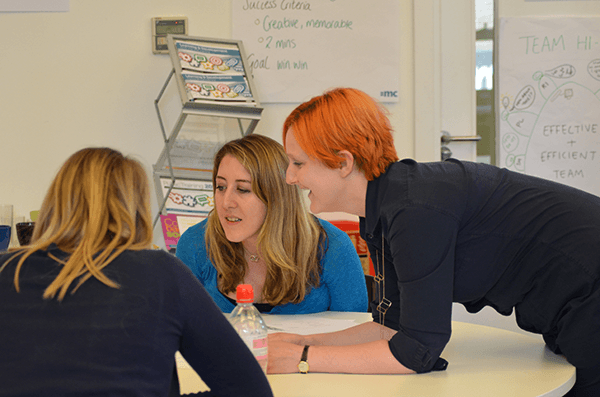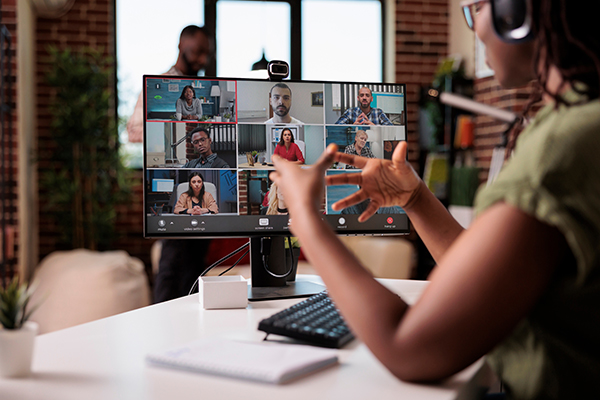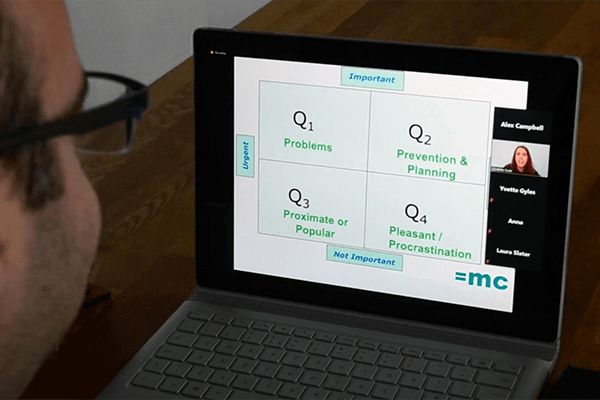Online learning was pushed into the spotlight a few years ago out of necessity. Since then, many of our customers still choose to develop their teams via a virtual classroom. Where face to face training has all the known benefits of physically being in the same learning environment, online opens up access to those in different locations, as well as offering many accessibility options. So which is best for your people – online or face to face training?

The answer to which training format is best is… it depends! It depends on what you are looking to achieve with your training – the change you want it to make for the participants and your organisation. In this blog, we’ll take you through some key points to help you figure out what would work best for your people.
There are some features that all training should have:
Which format delivers these best – online or face-to-face training?

We love meeting people, in rooms, in person. We’re trainers after all, and interacting with people is a massive motivation for doing this work. But training is not for, or about the trainer. It’s for and about the participant, their work, their stakeholders, and their organisational mission. So, why should you opt for face-to-face training?
Working with colleagues and peers in a classroom is an energising, engaging and enjoyable experience. Being in a dedicated learning space removes the group from their day-to-day work distractions, enabling them to focus and enrich their knowledge, skills and abilities. They will discuss their own examples and realities, hearing from others around them to shape their thinking, and share experiences. They can experiment with new approaches – trying things out and giving it a go.

Crucially, coming together is a great opportunity to build relationships with their colleagues, developing a network of ongoing support and breaking down silos, collaborating and solving problems together.
This kind of training works really well with:
Ultimately, this is a bonding experience, where participants discuss and share their ideas. Having tactile reminders of the day helps too. As does some catering or snacks!

We love it when participants make time, space and energy for their learning. People spend a lot of time online – in meetings, commuting, producing work and even shopping or entertaining themselves. Screen fatigue and being always-on can be a huge challenge for many people. So, why should you opt for your training to be online too?

Online learning can be easier for participants to access. Without the travel time, or physical challenges of getting into a specific location, an online space can be more accommodating for people. There are also built in accessibility options that participants can activate themselves – such as live captioning and screen readers.
Working online enables flexible learning and to work with colleagues and peers in different ways. Using breakout rooms gives participants a confidential, quiet space to speak freely about the challenges that they are facing and their ideas for making changes to the way that they work. Online learning also encourages plenty of personal reflection, enabling everyone to apply tools and ask questions as they go.

Crucially, working online means the only equipment your participants will need is a device where you can view documents, connect to the web, and use a camera and mic. Participants will be able to learn from anywhere. Our online learning days are shorter, in order to avoid screen fatigue, fitting into busy schedules.
This kind of training works really well with:
Ultimately, this is a developmental experience, where participants reflect on their work challenges and have time to really think through the actions they can take. Having digital, visual reminders helps, as does having regular screen breaks.
With both options presenting some great benefits, then surely the answer is blending the two together – with some participants in a room together with the facilitator, and some joining online from the comfort of their own space. Well, again, it depends…
Hybrid learning can of course bring together the best of both. It can also create a situation where you get the worst of both: set up issues, logistics problems, connection issues (both Wi-Fi and human) and fatigue.

To make hybrid learning work there are some additional considerations:
Therefore another way to combine these options is to have multiple learning events, with a mix of coming together sessions, and reflective online sessions.
When deciding which option is best for you, weigh up the outcomes you are trying to achieve (personal development, team connection, skills and application) with the practical realities you are facing (budget, logistics, technology, capacity and scheduling).
If you want to find out more about what our virtual and in-person classroom experiences are like contact us online or call 020 7978 1516 to speak to one of our Learning & Development consultants. You can also watch this video about learning in our online classroom to get a sense of what to expect.